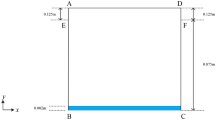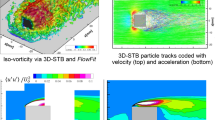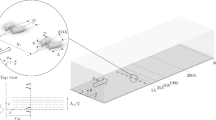Abstract
The present study mainly aims to investigate the performances of different turbulent models for the flow simulation around a circular cylinder at a critical Reynolds number regime (Re = 8.5×105, Tu = 0.7%). A hybrid RANS/LES model (SAS model), a correlation-based transition model (\(\gamma - \widetilde{\operatorname{Re} }_{\theta t} \) model), and a fully turbulent RANS model (SST model) were used to simulate various flow features, such as laminar-turbulence transition inside the boundary layer and the unsteady vortex shedding in the wake region, and their feasibilities for the flow simulation at a critical Reynolds number regime were demonstrated. A vertex-centered finite-volume method was used to discretize the incompressible Navier-Stokes equations, and an unstructured mesh technique was used to discretize the computational domain. The inviscid fluxes were evaluated using 2nd-order Roe’s flux difference splitting, and the viscous fluxes were computed based on central differencing. A dual time-stepping method and the Gauss-Seidel iteration were used for unsteady time integration. The parallelization strategy using METIS and MPI libraries was used to reduce computational costs. The unsteady characteristics and the time-averaged quantities of the flow fields were compared between turbulent models. The numerical results were also compared with experimental results. The turbulent models showed quite different results at the critical regime because of the different abilities of each model to predict various flow features, such as laminar-turbulence transition and unsteady vortex shedding.
Similar content being viewed by others
References
C. Reichel and K. Strohmeier, Application of models for laminar to turbulent transition to flow around a circular cylinder, Journal of Pressure Vessel Technology, 130 (2008) 031301-1–031301-8.
O. Yoshiyuki and T. Tetsuro, LES of flows around a circular cylinder in the critical reynolds number region, BBAA VI International Colloquium on: Bluff Bodies Aerodynamics & Applications, Milano, Italy (2008).
V. Guilherme, M. Christophe, V. Remmelt and G. Paul, Viscous flow computations on smooth cylinders a detailed numerical study with validation, 26 th International Conference on Offshore Mechanics and Arctic Engineering, OMAE 207-29275, San Diego, USA (2007).
M. M. Zdravkovich, Flow Around Circular Cylinders: A Comprehensive Guide Through Flow Phenomena, Experiments, Applications, Mathematical Models, and Computer Simulations, First Ed., Vol. 1, Oxford University Press, New York, USA (1997).
S. Szepessy and P. W. Bearman, Aspect ratio and end plate effects on vortex shedding from a circular cylinder, Journal of Fluid Mechanics, 234 (1992) 191–217.
E. Achenbach, Distribution of local pressure and skin friction around a circular cylinder in cross-flow up to Re=5×106, Journal of Fluid Mechanics, 34(4) (1968) 625–639.
F. R. Menter, Two-Equation eddy viscosity turbulence models for engineering applications, AIAA Journal, 32(8) (1994) 1598–1605.
F. R. Menter and Y. Egorov, A Scale-Adaptive simulation model using Two-Equation models, 43 rd AIAA Aerospace Science Meeting and Exhibit, AIAA 2005-1095, Reno, USA (2005).
F. R. Menter and Y. Egorov, The Scale-Adaptive simulation method for unsteady turbulent flow predictions. Part 1: Theory and Model Description, Flow, Turbulence and Combustion, 85 (2010) 113–138.
R. B. Langtry and F. R. Menter, Correlation-Based transition modeling for unstructured parallelized computational fluid dynamics codes, AIAA Journal, 47(12) (2009) 2894–2906.
Jr. G. W. Jones, J. J. Cincotta and R. W. Walker, Aerodynamic forces on a stationary and oscillating circular cylinder at high reynolds numbers, NASA/TR R-300 (1969).
Author information
Authors and Affiliations
Corresponding author
Additional information
Ju Yeol You is a Ph.D student at the Computational Aerodynamics and Design Optimization Laboratory in the Department of Aerospace Engineering, KAIST, Korea. His research interests are hybrid RANS/LES and turbulence modeling.
Oh Joon Kwon is a Professor in the Department of Aerospace Engineering, KAIST, Korea. His research interests are CFD based on an unstructured mesh technique, design optimization and rarefied gas dynamics.
Rights and permissions
About this article
Cite this article
You, J.Y., Kwon, O.J. Numerical assessment of turbulent models at a critical regime on unstructured meshes. J Mech Sci Technol 26, 1363–1369 (2012). https://doi.org/10.1007/s12206-012-0319-5
Received:
Revised:
Accepted:
Published:
Issue Date:
DOI: https://doi.org/10.1007/s12206-012-0319-5




